Laser patterning of non-linear optical Bi2ZnB2O7 crystal lines in glass
- Department of Materials Science and Technology, Nagaoka University of Technology, Nagaoka, Japan
Bi2O3-based glasses are very attractive from the viewpoints of low-melting, high refractive index, and crystallization, and the research on their glasses and glass-ceramics is at the frontiers of glass science and technology. Non-linear optical Bi2ZnB2O7 crystal lines with a high orientation were patterned in 3Sm2O3-30.3Bi2O3-33.3ZnO-33.3B2O3 glass by using a laser-induced crystallization technique. It was confirmed from transmission electron microscope observations that crystals were formed in the inside of the glass, i.e., at the beneath of 4 μm from the surface, although lasers (Yb:YVO4 laser with a wavelength of 1080 nm) were focused at the glass surface. A new potential for optical device applications was added in Bi2O3-based glasses from the present study.
Introduction
Micro-fabrications in glassy materials have found increasingly more applications in optoelectronics, telecommunications, and photonic devices such as optical gratings and waveguides, and laser irradiation to glasses has received considerable attention as a new tool of spatially selected micro-fabrications in glasses. For instance, a permanent change of refractive index can be induced in Ge-doped SiO2 optical fibers by using ultraviolet laser irradiations to produce Bragg gratings under suitable exposure conditions. Spatially selected patterning of crystals in glasses by laser irradiations, i.e., laser-induced crystallization, is also extremely attractive, which is a new method for the design and control of the crystallization of glasses in comparison with the conventional crystallization technique using an electric furnace, and also opens a new door in crystal growth and patterning engineering. The design and control of the crystallization of glasses by using lasers are at the frontiers of the glass science and technology.
The present authors group proposed new laser irradiation techniques for the patterning of crystals with dot, line, and two-dimensional planar shapes in glasses, i.e., the rare-earth atom heat (REAH) processing and transition metal atom heat (TMAH) processing (Sato et al., 2001; Honma et al., 2003, 2006; Komatsu et al., 2007; Komatsu and Honma, 2013), and various crystals such as ferroelectric LiNbO3 (Honma and Komatsu, 2010; Komatsu et al., 2011), multi-ferroic β′-RE2(MoO4)3 (RE: rare-earth) (Tsukada et al., 2009; Suzuki et al., 2010), non-linear optical Li2Si2O5 (Honma et al., 2008), oxyfluoride BaAlBO3F2 (Shinozaki et al., 2012), and fluoride CaF2 (Shinozaki et al., 2013) have been patterned successfully in glasses. In the laser-induced crystallization, a steep temperature gradient is created in the laser irradiated local region and such a steep temperature gradient is moved along laser scanning direction, consequently providing the patterning of crystals with a high orientation. It is of very importance to apply the laser-induced crystallization technique to various glasses, and such studies will lead a more deep understanding of the crystallization of glasses and also the possibility of new device applications of crystallized glasses (glass-ceramics).
In this study, we focus our attention on the patterning of non-linear optical Bi2ZnB2O7 crystal lines with a high orientation in Bi2O3–ZnO–B2O3 glasses by using a laser-induced crystallization technique. Recently, Bi2MB2O7 crystals (M = Zn, Sr, and Ca) have been successfully synthesized through the crystallization of corresponding glasses (Majhi and Varma, 2008a,b; Kanenishi et al., 2012; Shanmugavelu and Kumar, 2012). In particular, Bi2ZnB2O7 with an orthorhombic structure is of interest, because Bi2ZnB2O7 exhibits excellent non-linear optical properties (Barbier et al., 2005) and is crystallized from 33.3Bi2O3-33.3ZnO-33.3B2O3 glass corresponding to the stoichiometric composition of Bi2ZnB2O7. The values of second-order optical non-linearities, d31 = 0.911 pm/V, d32 = 3.083 pm/V, and d33 = 1.015 pm/V, have been reported for Bi2ZnB2O7 single crystal (Su et al., 2013). Very recently, transparent glass-ceramics containing Bi2ZnB2O7 nanocrystals have been synthesized in 30Bi2O3-40ZnO-30B2O3 glass, and it has been found that they exhibit a large third-order optical non-linearity (Zeng et al., 2014). Furthermore, Bi2ZnB2O7 nanocrystals have been patterned in ZnO–Bi2O3–B2O3 glasses by irradiations of femtosecond laser (Liu et al., 2015). There has been, however, no report on the laser patterning of Bi2ZnB2O7 crystal lines (not dots) with a high orientation in glasses so far. In a previous paper (Inoue et al., 2010), we examined the features of electronic polarizability (optical basicity) and chemical bonding state in Bi2O3–ZnO–B2O3 glasses from density, refractive index, Raman scattering spectrum, and X-ray photoelectron spectrum (XPS) measurements, and proposed the formation of B–O–Bi and B–O–Zn bridging bonds in the glass structure. In this paper, we demonstrated that Bi2ZnB2O7 crystal lines with a high orientation were patterned in Bi2O3–ZnO–B2O3 glasses by laser irradiations for the first time. Glasses based on the Bi2O3–ZnO–B2O3 system have also received much attention as new low-melting and shielding glasses (Maeder, 2013), and from this point of view, the understanding of the crystallization behaviors of Bi2O3–ZnO–B2O3 glasses is extremely important. The laser patterning of functional crystals in Bi2O3-based glasses has a great potential in application of non-linear optical integrated devices (Liu et al., 2015), and is at the frontiers of glass science and technology in Bi2O3-based glasses.
Experimental Section
Glasses with the compositions of 33.3Bi2O3-33.3ZnO-33.3Bi2O3 and xSm2O3-(33.3-x)Bi2O3-33.3ZnO-33.3B2O3 (x = 1, 3, and 5) were prepared by using a conventional melt quenching technique. Commercial powders of reagent grade ZnO, Bi2O3, H3BO3, and Sm2O3 were melted in a platinum crucible at 1000°C for 30 min in an electric furnace. The melts were poured onto an iron plate and pressed to a thickness of ~1.5 mm by another iron plate. Glass transition (Tg) and crystallization peak temperatures (Tp) were determined by using differential thermal analysis (DTA) at a heating rate of 10 K/min. The quenched glasses were annealed at Tg for 30 min to release internal stresses. Densities of glasses were determined with the Archimedes method using distilled water as an immersion liquid (Inoue et al., 2010). Refractive indices at a wavelength (λ) of 632.8 nm (He–Ne laser) were measured at room temperature with a prism coupler (Metricon Model 2010). The melt-quenched plate-shaped glasses were heat-treated at some temperatures in an electric furnace, i.e., at 450–530°C for 3 h, and the crystalline phases formed were identified by using X-ray diffraction (XRD) analysis at room temperature. Raman scattering spectra at RT for the glasses and heat-treated samples were measured with a laser microscope (Tokyo Instruments Co., Nanofinder) operated at Ar+ laser (wavelength: λ = 488 nm). In this apparatus, the data below 250 cm−1 cannot be measured due to the use of an edge filter.
Glasses were mechanically polished to a mirror finish with CeO2 powders. The glass was irradiated by cw Yb:YVO4 fiber laser (beam shape: single mode and ± 1 nm bandwidth) with λ = 1080 nm using objective lens (magnification: 50 times, numerical aperture: NA = 0.8). The laser beam was unpolarized and the diameter of laser spot was 2~3 μm. Plate-shaped glasses with a thickness of ~ 1 mm were put on the stage and mechanically moved during laser irradiations to pattern crystals. The crystalline phase in the laser-irradiated part was examined from micro-Raman scattering spectrum measurements. Second harmonic generation (SHG) microscopic measurements were performed for the laser-irradiated part using a Q-switched Nd:YAG (yttrium aluminum garnet) laser with λ = 1064 nm as a fundamental light source. SHG emissions (λ = 532 nm) were measured, although the fundamental one must be isolated by a cut-off filter before reaching to the CCD (Charged Coupled Devices) for image detection (Fujiwara et al., 2003). The morphology of crystals in laser-patterned lines were examined by using a transmission electron microscope (TEM: FE-TEM, JEOL, JEM-2100F) operating at 200 kV. Thin foils for TEM observations were prepared with a focused Ga ion beam (FIB) (JEOL, JIB-4500) method.
Results and Discussion
Crystallization Behavior of 33.3Bi2O3-33.3ZnO-33.3B2O3 Glass
Prior to the laser patterning of Bi2ZnB2O7 crystal lines in Bi2O3–ZnO–B2O3 glasses, it is necessary to confirm the formation of Bi2ZnB2O7 crystals in the crystallization of a given glass. Basically, the crystalline phase formed by laser irradiations in glasses is the same as that formed by heat treatments in an electric furnace. The glass with the composition of 33.3Bi2O3-33.3ZnO-33.3B2O3 corresponding to the stoichiometric composition of the Bi2ZnB2O7 crystalline phase is designated here as 111BiZnB glass.
Figure 1 shows the DTA patterns for the bulk and powdered samples of as-quenched 111BiZnB glasses. In both samples, endothermic dips due to the glass transition and exothermic peaks due to the crystallization are detected clearly, providing the values of Tg = 395°C and Tp = 562°C for the bulk sample and Tg = 395°C and Tp = 551°C for the powdered sample. It is noted that the crystallization peak temperature (Tp = 562°C) for the bulk sample is close to that (Tp = 551°C) for the powdered sample, implying the possibility of the so-called bulk crystallization in the inside of glass. In Figure 1, the optical microscope photograph for the base glass is included. The glass is colorless in the visible region. The density (d) and refractive index (n) of 111BiZnB glass at room temperature are d = 6.53 g/cm3 and n = 2.06, respectively.
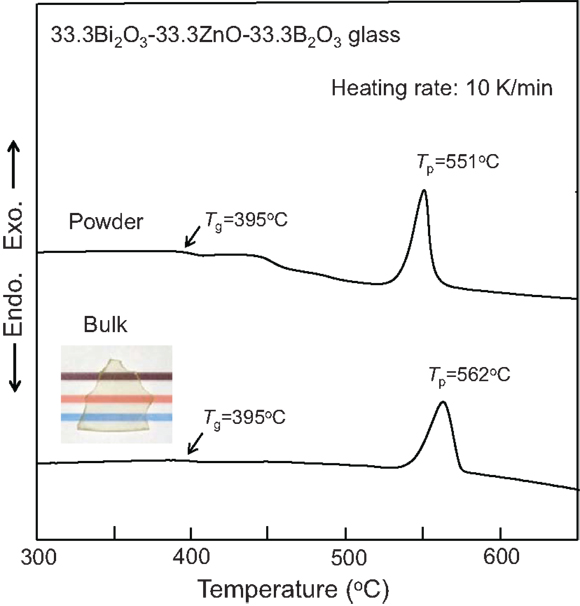
Figure 1. DTA patterns for the bulk and powdered samples of as-quenched glass. Tg and Tp are the glass transition and crystallization peak temperatures, respectively. Heating rate was 10 K/min. The optical microscope photograph for the base glass is included.
Figure 2 shows the XRD patterns at room temperature for the 111BiZnB samples obtained by different heat treatment temperatures for 3 h in air. In these XRD measurements, the bulk samples were used without any pulverizing and thus information on the crystalline phase being present at and near the glass surface is obtained. As seen in Figure 2, the formation of Bi2ZnB2O7 crystals is confirmed in the samples heat-treated at 470, 500, and 530°C. Another crystalline phase is formed initially, which has not been identified (i.e., unknown crystalline phase) in our study. It has been reported that the β-BiB3O6 crystalline phase is formed initially in the crystallization of 111BiZnB glass (Shanmugavelu and Kumar, 2012). In Figure 2, the optical microscope photograph for the sample heat-treated at 470°C is included. It is seen that the surface of the bulk sample is rounded. This behavior indicates that the softening/deformation of samples and crystallization occur almost simultaneously during heat treatments in 111BiZnB glass (Kanenishi et al., 2012). The high thermal stability against the crystallization in 111BiZnB glass, i.e., ΔT = Tp−Tg = 562°C−395°C = 167°C, would be one of the reasons for the sample deformation during heat treatments. As seen in Figure 2, the formation of unknown crystalline phase is detected in the sample heat-treated at 450°C from the XRD pattern; but in the sample heat-treated at 470°C, the formation of such an unknown crystalline phase is not confirmed. The crystallization at the glass surface is influenced by various factors such as surface quality, tips, cracks and scratches, foreign particles, and surrounding atmosphere in a given glass, i.e., the surface state (Müller et al., 2000). The shape of the sample heat-treated at 470°C was changed, i.e., the rounded shape (see Figure 2). This means that the surface state is largely changed in the heat treatment at 470°C, and thus the surface crystallization behavior would be influenced, providing the formation behavior of the unknown crystalline phase.
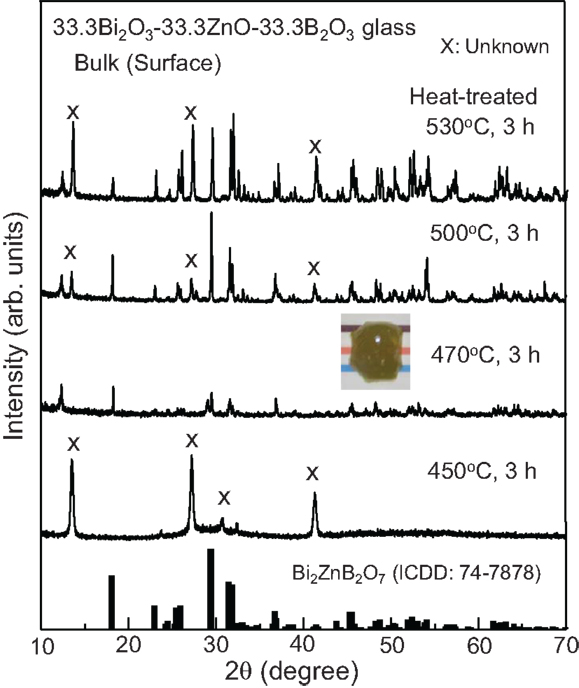
Figure 2. XRD patterns at room temperature for the bulk (i.e., surface) samples obtained by different heat treatment temperatures for 3 h in air. The optical microscope photograph for the sample heat-treated at 470°C is included.
Figure 3 shows the XRD patterns at room temperature for the powdered samples, in which bulk plate-shape glasses were heat-treated and the samples were pulverized after heat treatments. Figure 3 provides, therefore, information mainly on the crystalline phase present in the interior of samples. All XRD peaks in Figure 3 are assigned to the Bi2ZnB2O7 crystalline phase (ICDD: 74–7878), indicating that only the Bi2ZnB2O7 crystalline phase is formed in all samples heat-treated at 450–530°C for 3 h in air. SHGs were confirmed in the crystallized samples (data are not shown here), indicating that the Bi2ZnB2O7 crystalline phase formed in 111BiZnB glass exhibits the second-order optical non-linearity. Figure 4 shows the Raman scattering spectra at room temperature for the base glass and crystallized (530°C, 3 h) samples. The glass shows very broad peaks being typical for glassy materials in the Raman scattering spectrum, i.e., at ~350, ~600, ~920, 1150 ~ 1400, and ~1550 cm−1. From the Raman scattering spectra for various Bi2O3–ZnO–B2O3 glasses such as 30Bi2O3-30ZnO-40B2O3, the formation of B–O–Bi and B–O–Zn bridging bonds in the glass structure has been proposed (Inoue et al., 2010). The broad peaks observed in Figure 4 would be assigned as follows: (1) the band at 350 cm−1 can be connected with a symmetric stretching motion in Bi–O–Bi bonds between BiO6 groups; (2) the band at 600 cm−1 could be assigned to symmetric stretching motions in B–O–Bi and B–O–Zn bonds; (3) the band at 920 cm−1 can be related mainly to asymmetric stretching motions in B–O–Bi and B–O–Zn bonds; (4) the bands at 1150 ~ 1400 and ~1550 cm−1 can be assigned to an asymmetric stretching vibration of B–O bonds in BO3 groups. On the other hand, the crystallized sample shows several sharp peaks at 347, 382, 497, 537, 577, 632, 699, and 741 cm−1 together with broad and weak peaks at 877, 1243, 1340, and 1548 cm−1. Because Bi2ZnB2O7 crystals are formed in the crystallized sample, it is obvious that the Raman scattering spectrum shown in Figure 4 is for the Bi2ZnB2O7 crystalline phase. In Bi2ZnB2O7 with an orthorhombic structure (a = 1.0827 nm, b = 1.10329 nm, and c = 0.48848 nm) (Barbier et al., 2005), octahedral BiO6 units, tetrahedral ZnO units, BO3 and BO4 units are present. ZnO4 units and BO3/BO4 units are connected through a corner-shared bonding, i.e., the presence of B–O–Zn bonds, and are creating layers. The Bi2ZnB2O7 crystalline phase is, therefore, constructed from the stacking of BiO6, ZnO4, BO3, and BO4 units. At this moment, the peaks shown in Figure 4 have not been assigned in detail. However, the Raman scattering spectrum for Bi2ZnB2O7 crystals would be used for the confirmation of the presence of Bi2ZnB2O7 crystals in laser-patterned lines.
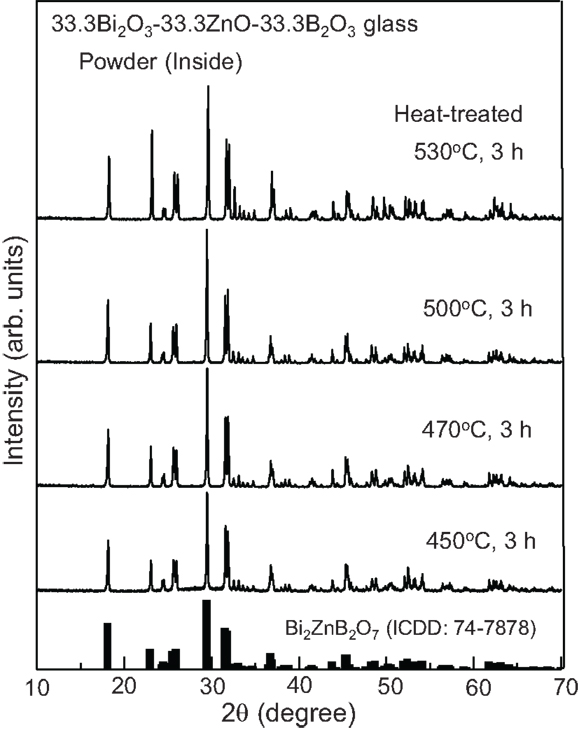
Figure 3. XRD patterns at room temperature for the powdered (i.e., inside) samples obtained by different heat treatment temperatures for 3 h in air. All XRD peaks are assigned to the Bi2ZnB2O7 crystalline phase (ICDD: 74–7878).
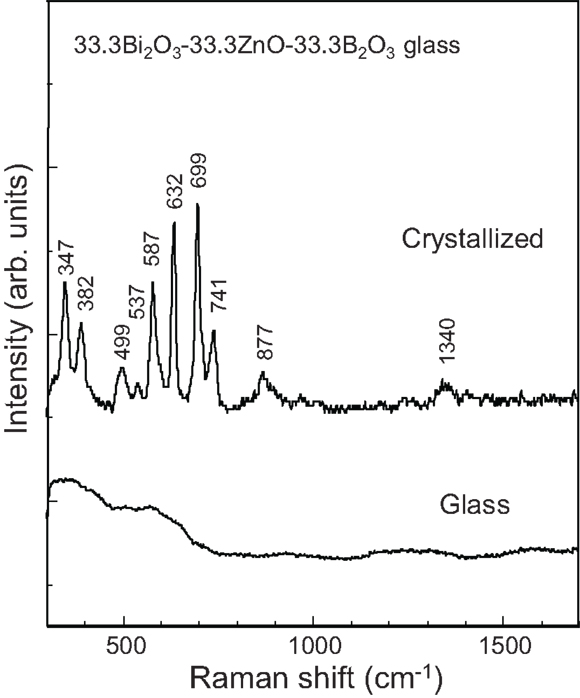
Figure 4. Raman scattering spectra at room temperature for the base glass and crystallized (530°C, 3 h) samples.
Laser Pattering of Bi2ZnB2O7 Crystal Lines
In the laser-induced crystallization technique proposed and applied by our group (Komatsu et al., 2007; Komatsu and Honma, 2013), some amounts of rare-earth ions such as Sm3+ or transition metal ions such as Ni2+ must be included into the base glass for the absorption of laser. In this study, the glasses with the compositions of xSm2O3-(33.3-x)Bi2O3-33.3ZnO-33.3B2O3 (x = 1, 3, and 5) were prepared. The melt-quenched samples with these compositions were confirmed to be glasses from XRD and DTA measurements.
For the glass with 1Sm2O3 (x = 1), it was found that laser irradiations with different conditions such as the laser powers of P = 1.3–1.5 W and the laser scanning speed of S = 1.5 μm/s did not induce any crystallization. Furthermore, for the glass with 5Sm2O3 (x = 5), it was difficult to pattern crystal lines with a homogeneous morphology. Here, therefore, the results for the glass with 3Sm2O3 (x = 3), i.e., 3Sm2O3-30.3Bi2O3-33.3ZnO-33.3B2O3 (designated here as 3Sm-111BiZnB glass) are presented. The 3Sm-111BiZnB glass has the values of Tg = 410°C and Tp = 553°C. Because of the substitution of Sm2O3 for Bi2O3, the glass transition temperature is becoming high and the crystallization temperature is low compared with the 111BiZnB glass (Tg = 395°C and Tp = 562°C) with no Sm2O3. The value of the optical absorption coefficient (α) at λ = 1080 nm (Yb:YVO4 laser) was α = 10.5 cm−1 for 3Sm-111BiZnB glass. The reflection of light at the glass surface calculated using the Fresnel’s equation was considered in the estimation of α (i.e., Lambert–Beer law).
Figure 5 shows the polarized optical microphotographs (POMs) for the samples obtained by laser irradiations. The laser scanning speed was fixed to S = 1.5 μm/s, and the laser power was changed in the range of P = 1.30–1.50 W. The laser was focused at the surface (not in the inside). The lines patterned with P = 1.30–1.45 W show a homogeneous distribution in color along the laser scanning direction, indicating that a stable structural change is taking place under these laser irradiation conditions. The morphology of the line patterned with P = 1.50 W is not homogeneous. Figure 6 shows the micro-Raman scattering spectra at room temperature for the lines patterned by laser irradiations with P = 1.35 and 1.50 W. In both lines, several sharp peaks are observed and the positions of these peaks are almost similar to the Bi2ZnB2O7 crystalline phase (Figure 4), indicating that the lines patterned with P = 1.35 and 1.50 W consist of Bi2ZnB2O7 crystals. In Figure 6, the SHG microscopy images of these lines are presented, indicating that SHG emissions are founded to be caused by only the crystal lines. Similar results were obtained for other lines patterned with P = 1.30, 1.40, and 1.45 W.
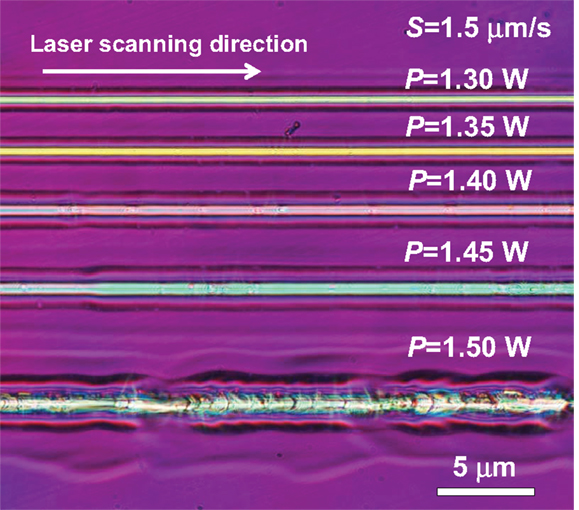
Figure 5. Polarized optical microphotographs for the samples obtained by laser irradiations with the laser powers of P = 1.3–1.5 W and a laser scanning speed of S = 1.5 μm/s.
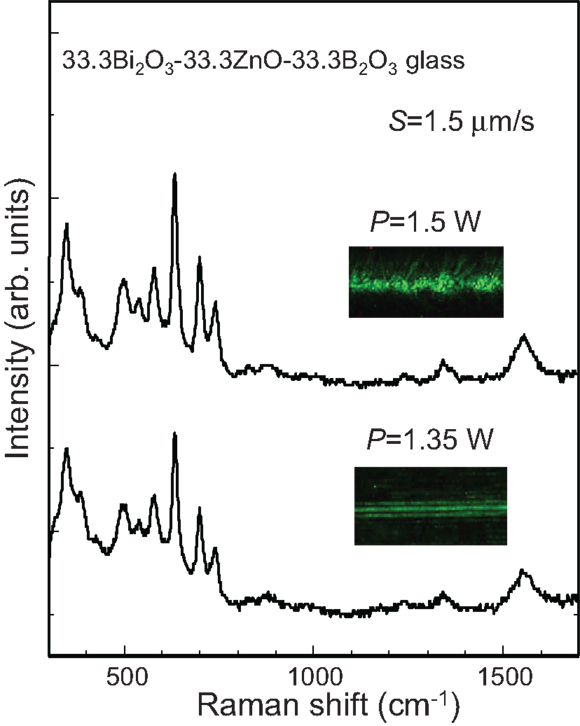
Figure 6. Micro-Raman scattering spectra at room temperature for the lines patterned by laser irradiations with P = 1.35 and 1.50 W.
In order to examine the morphology and orientation of Bi2ZnB2O7 crystals in the line patterned by laser irradiations with S = 1.5 μm/s and P = 1.35 W by using TEM observations, the line part was processed to a thin foil (~100 nm) shape using a FIB method. Figure 7 shows the bright field image and selected area electron diffraction (SAED) pattern in TEM observations for the cross-section of the line. Almost a homogeneous bright field image is observed over the whole crystallized part. In the SAED, the diffraction spots are observed clearly. These results suggest that Bi2ZnB2O7 crystals in the cross-section (i.e., in the line) are highly oriented, and the line is not constructed from the assembly of Bi2ZnB2O7 polycrystals. In order to determine definitely the orientation direction/quality of Bi2ZnB2O7 crystals in the lines patterned, further TEM observations are required (Fan et al., 2012). In the present study, the laser focal position was the surface. However, as seen in Figure 7, Bi2ZnB2O7 crystals were formed in the inside of the glass, i.e., at the beneath of 4 μm from the surface. Usually, if the laser focal position is the surface of a given glass, crystals are basically formed at the glass surface [e.g. Komatsu et al. (2007) and Komatsu and Honma (2013)]. The crystal growth in the inside of the glass (Figure 7) observed in this study might be closely related to the high thermal stability (i.e., ΔT = Tp−Tg = 167°C) against the crystallization in the glass of 3Sm2O3-30.3Bi2O3-33.3ZnO-33.3B2O3. As shown in Figures 2 and 3, although unknown crystals are formed initially at the glass surface, the main crystalline phase formed in the inside is the Bi2ZnB2O7 crystalline phase. This would be one of the reasons for the formation of Bi2ZnB2O7 crystals in the lines patterned by laser irradiations. Recently, non-linear optical β-BaB2O4 (β-BBO) crystal lines have been successfully patterned in the inside (up to the beneath of ~200 μm) of 8Sm2O3-42BaO-50B2O3 glass by laser irradiations, in which the laser focal position was moved gradually from the surface to the inside (Nishii et al., 2015). The present study suggests that the patterning of Bi2ZnB2O7 crystal lines would be possible even in the inside of more deep beneath around 100 μm for Bi2O3–ZnO–B2O3 glasses by changing the laser focal position.
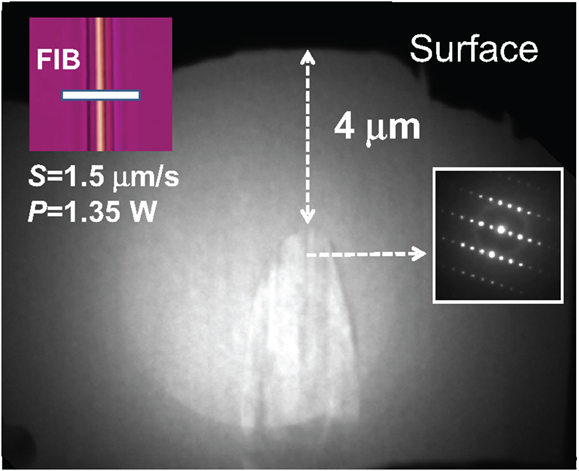
Figure 7. A bright field image and selected area electron diffraction (SAED) pattern in TEM observations for the cross-section of the line patterned by laser irradiations with S = 1.5 μm/s and P = 1.35 W.
Frontiers of Laser Pattering of Crystals in Bi2O3-Based Glasses
Nowadays, it has been well recognized that Bi2O3 oxide is one of the important constituents for the design and control of optical, electrical, and thermal properties of oxide glasses, and numerous studies on Bi2O3-based glasses have been studied so far (Dumbaugh, 1986; Maeder, 2013). The most attractive features of Bi2O3 oxide are a large electronic polarizability and a weak single bond strength of Bi–O bonds (Dimitrov and Komatsu, 1999, 2002, 2005, 2010; Komatsu et al., 2010). Indeed, glasses with Bi2O3 exhibit large third order non-linear optical susceptibilities χ(3) of the order 10−12 esu (Terashima et al., 1997). Recently, Bi2O3–ZnO–B2O3 glasses have received much attention (Kim et al., 2007; Doweidar and Saddeek, 2009; Inoue et al., 2010; Hashimoto et al., 2011), in particular, because they are low melting glasses with high thermal stability and have been used as new sealing glasses instead of PbO-containing low melting glasses. The crystallization of Bi2O3-based glasses has also received much attention, because some functional crystals containing Bi2O3 are formed through the crystallization. For instance, high-Tc Bi2O3-based copper superconducting glass-ceramics have been synthesized through the crystallization of glasses with Bi2O3 (Komatsu et al., 1988, 1990). Non-linear optical RExBi1–xBO3 crystals (RE: Gd and Sm) showing strong SHGs have been also synthesized from RE2O3–Bi2O3–B2O3 glasses (Honma et al., 2002; Ihara et al., 2004; Koshiba et al., 2007). The design and control of new Bi2O3-based glasses and their crystallization are at the frontiers of the glass science and technology.
In this study, we demonstrated that non-linear optical Bi2ZnB2O7 crystal lines with a homogeneous morphology and a high orientation are patterned in 3Sm2O3-30.3Bi2O3-33.3ZnO-33.3B2O3 glass for the first time. Crystallized glasses (glass-ceramics) are composites of the glassy phase and crystalline phase, i.e., glass/crystal hybrid materials. In particular, the combination of glass and single crystal line would have a high potential for device applications. It is emphasized that a new potential for optical device applications is added in Bi2O3-based glasses from the present study. A large single crystal and crystal fibers of Bi2ZnB2O7 have been fabricated in order to develop new solid state lasers with high transparency in the ultra-violet region (Kozhayam et al., 2013; Su et al., 2013). The laser patterning of Bi2ZnB2O7 crystal lines in glasses is a new and innovative approach for the single crystal growth technique. Very recently, non-linear optical β-BBO crystal lines with bending and curved shapes have been patterned at the glass surface, and it has been demonstrated from birefringence imaging measurements that highly c-axis oriented β-BBO crystals grow along laser scanning direction even if the laser scanning direction changes (Ogawa et al., 2013). As further studies, the patterning of bending and curved Bi2ZnB2O7 crystal lines is strongly required in Bi2O3–ZnO–B2O3 glasses.
Conclusion
Non-linear optical Bi2ZnB2O7 crystal lines with a high orientation were patterned in 3Sm2O3-30.3Bi2O3-33.3ZnO-33.3B2O3 glass by using a laser-induced crystallization technique for the first time, in which continuous-wave Yb:YVO4 fiber lasers with a wavelength of 1080 nm were irradiated at the glass surface. It was confirmed from transmission electron microscope observations that crystals were formed in the inside of the glass, i.e., at the beneath of 4 μm from the surface. A new potential for optical device applications was added in Bi2O3-based glasses from the present study.
Conflict of Interest Statement
The authors declare that the research was conducted in the absence of any commercial or financial relationships that could be construed as a potential conflict of interest.
Acknowledgments
This work was supported from the Grant-in-Aid for Scientific Research from the Ministry of Education, Science, Sports, Culture and Technology, Japan (No. 23246114) and by Program for High Reliable Materials Design and Manufacturing in Nagaoka University of Technology.
References
Barbier, J., Penin, N., and Cranswick, L. M. (2005). Melilite-type borates Bi2ZnB2O7 and CaBiGaB2O7. Chem. Mater. 17, 3130–3136. doi:10.1021/cm0503073
Dimitrov, V., and Komatsu, T. (1999). Electronic polarizability, optical basicity and nonlinear optical properties of oxide glasses. J. Non Cryst. Solids 249, 160–179. doi:10.1016/S0022-3093(99)00317-8
Dimitrov, V., and Komatsu, T. (2002). Classification of simple oxides: a polarizability approach. J. Solid State Chem. 163, 100–112. doi:10.1006/jssc.2001.9378
Dimitrov, V., and Komatsu, T. (2005). Classification of oxide glasses: a polarizability approach. J. Solid State Chem. 178, 831–846. doi:10.1016/j.jssc.2004.12.013
Dimitrov, V., and Komatsu, T. (2010). Average single bond strength and optical basicity of Bi2O3-B2O3 and Sb2O3-B2O3 glasses. J. Non Cryst. Solids 356, 258–262. doi:10.1016/j.jnoncrysol.2009.11.014
Doweidar, H., and Saddeek, Y. B. (2009). FTIR and ultrasonic investigations on modified bismuth borate glasses. J. Non Cryst. Solids 355, 348–354. doi:10.1016/j.jnoncrysol.2008.12.008
Dumbaugh, W. H. (1986). Heavy metal oxide glasses containing Bi2O3. Phys. Chem. Glasses 27, 119–123.
Fan, C., Poumellec, B., Lancy, M., He, X., Zeng, H., Erraji-Chahid, A., et al. (2012). Three-dimensional photoprecipitation of oriented LiNbO3-like crystals in silica-based glass with femtosecond laser irradiation. Opt. Lett. 37, 2955–2957. doi:10.1364/OL.37.002955
Fujiwara, T., Sawada, T., Honma, T., Benino, Y., Komatsu, T., Takahashi, M., et al. (2003). Origin of intrinsic second-harmonic generation in crystallized GeO2-SiO2 glass films. Jpn. J. Appl. Phys. 42, 7326–7330. doi:10.1143/JJAP.42.7326
Hashimoto, T., Shimada, Y., Nasu, H., and Ishida, A. (2011). ZnO-Bi2O3-B2O3 glasses as molding glasses with high refractive indices and low coloration codes. J. Am. Ceram. Soc. 94, 2061–2066. doi:10.1111/j.1551-2916.2010.04383.x
Honma, T., Benino, Y., Fujiwara, T., Sato, R., and Komatsu, T. (2002). Optical nonlinear crystalline dot and line patterning in samarium bismuth borate glasses by YAG laser irradiation. J. Ceram. Soc. Jpn. 110, 398–402. doi:10.2109/jcersj.110.398
Honma, T., Benino, Y., Fujiwara, T., Komatsu, T., and Sato, R. (2003). Nonlinear optical crystal line writing in glass by yttrium aluminium garnet laser irradiation. Appl. Phys. Lett. 82, 892–894. doi:10.1063/1.1544059
Honma, T., Benino, Y., Fujiwara, T., and Komatsu, T. (2006). Transition metal atom heat processing for writing of crystal lines in glass. Appl. Phys. Lett. 88, 231105. doi:10.1063/1.2212272
Honma, T., and Komatsu, T. (2010). Patterning of two-dimensional planar lithium niobate architectures on glass surface by laser scanning. Opt. Express 18, 8019–8024. doi:10.1364/OE.18.008019
Honma, T., Nguyen, P. T., and Komatsu, T. (2008). Crystal growth behavior in CuO-doped lithium disilicate glasses by continuous-wave fiber laser irradiation. J. Ceram. Soc. Jpn. 116, 1314–1318. doi:10.2109/jcersj2.116.1314
Ihara, R., Honma, T., Benino, Y., and Komatsu, T. (2004). Second-order optical nonlinearities of metastable BiBO3 phases in crystallized glasses. Opt. Mater. 27, 403–408. doi:10.1016/j.optmat.2004.07.002
Inoue, T., Honma, T., Dimitrov, V., and Komatsu, T. (2010). Approach to thermal properties and electronic polarizability from average single bond strength in ZnO-Bi2O3-B2O3 glasses. J. Solid State Chem. 183, 3078–3085. doi:10.1016/j.jssc.2010.10.027
Kanenishi, K., Sakida, S., Benino, Y., and Nanba, T. (2012). Surface crystallization of stoichiometric glass with Bi2ZnB2O7 crystal using ultrasonic surface treatment followed by heat treatment. J. Ceram. Soc. Jpn. 120, 509–512. doi:10.2109/jcersj2.120.509
Kim, B. S., Lim, E. S., Lee, J. H., and Kim, J. J. (2007). Effect of structure change on thermal and dielectric characteristics in low-temperature firing Bi2O3-B2O3-ZnO glasses. J. Mater. Sci. 42, 4260–4264. doi:10.1007/s10853-006-0638-y
Komatsu, T., Sato, R., Imai, K., Matusita, K., and Yamashita, T. (1988). High-Tc superconducting glass ceramics based on the Bi-Ca-Sr-Cu-O system. Jpn. J. Appl. Phys. 27, L550–L552. doi:10.1143/JJAP.27.L533
Komatsu, T., Hirose, C., Ohki, T., Sato, R., and Matusita, K. (1990). Preparation of Ag-coated superconducting Bi2Sr2CaCu2Ox glass ceramic fibers. Appl. Phys. Lett. 57, 183–185. doi:10.1063/1.103978
Komatsu, T., and Honma, T. (2013). Laser patterning and characterization of optical active crystals in glasses (review). J. Asian Ceram. Soc. 1, 9–16. doi:10.1016/j.jascer.2013.02.006
Komatsu, T., Ihara, R., Honma, T., Benino, Y., Sato, R., Kim, H. G., et al. (2007). Patterning of nonlinear optical crystals in glass by laser-induced crystallization. J. Am. Ceram. Soc. 90, 699–705. doi:10.1111/j.1551-2916.2006.01441.x
Komatsu, T., Ito, N., Honma, T., and Dimitrov, V. (2010). Electronic polarizability and its temperature dependence of Bi2O3-B2O3 glasses. J. Non Cryst. Solids 356, 2310–2314. doi:10.1016/j.jnoncrysol.2010.03.041
Komatsu, T., Koshiba, K., and Honma, T. (2011). Preferential growth orientation of laser-patterned LiNbO3 crystals in lithium niobium silicate glass. J. Solid State Chem. 184, 411–418. doi:10.1016/j.jssc.2010.12.016
Koshiba, K., Honma, T., Benino, Y., and Komatsu, T. (2007). Patterning and morphology of nonlinear optical GdxBi1-xBO3 crystals in Gd2O3-Bi2O3-B2O3 glasses by YAG laser irradiation. Appl. Phys. A 89, 981–986. doi:10.1007/s00339-007-4200-9
Kozhayam, N., Ferriol, M., Cochez, M., and Aillerie, M. (2013). Growth and characterization of bismuth zinc borate Bi2ZnB2O7 crystal fibers by the micro-pulling down technique. J. Cryst. Growth 364, 51–56. doi:10.1016/j.jcrysgro.2012.11.059
Liu, Z., Zeng, H., Ji, X., Ren, J., Chen, G., Ye, J., et al. (2015). Formation of Bi2ZnB2O7 nanocrystals in ZnO-Bi2O3-B2O3 glass induced by femtosecond laser. J. Am. Ceram. Soc. 98, 408–412. doi:10.1111/jace.13330
Maeder, T. (2013). Review of Bi2O3 based glasses for electronics and related applications. Int. Mater. Rev. 58, 3–40. doi:10.1179/1743280412Y.0000000010
Majhi, K., and Varma, K. B. R. (2008a). Structural, dielectric and optical properties of transparent glasses and glass-ceramics of SrBi2B2O7. J. Non Cryst. Solids 354, 4543–4549. doi:10.1016/j.jnoncrysol.2008.06.010
Majhi, K., and Varma, K. B. R. (2008b). Structural, dielectric and optical properties of CaBi2B2O7 glasses and glass-nanocrystal composites. Mater. Chem. Phys. 117, 494–499. doi:10.1016/j.matchemphys.2009.06.044
Müller, R., Zanotto, E. D., and Fokin, V. M. (2000). Surface crystallization of silicate glasses: nucleation sites and kinetics. J. Non Cryst. Solids 274, 208–231. doi:10.1016/S0022-3093(00)00214-3
Nishii, A., Shinozaki, K., Honma, T., and Komatsu, T. (2015). Morphology and orientation of β-BaB2O4 crystals patterned by laser in the inside of samarium barium borate glass. J. Solid State Chem. 221, 145–151. doi:10.1016/j.jssc.2014.09.031
Ogawa, K., Honma, T., and Komatsu, T. (2013). Birefringence imaging and orientation of laser patterned β-BaB2O4 crystals with bending and curved shapes in glass. J. Solid State Chem. 207, 6–12. doi:10.1016/j.jssc.2013.08.021
Sato, R., Benino, Y., Fujiwara, T., and Komatsu, T. (2001). YAG laser-induced crystalline dot patterning in samarium tellurite glasses. J. Non Cryst. Solids 289, 228–232. doi:10.1016/S0022-3093(01)00736-0
Shanmugavelu, B., and Kumar, V. V. R. K. (2012). Crystallization kinetics and phase transformation of bismuth zinc borate glass. J. Am. Ceram. Soc. 95, 2891–2898. doi:10.1111/j.1551-2916.2012.05342.x
Shinozaki, K., Honma, T., and Komatsu, T. (2012). New oxyfluoride glass with high fluorine content and laser patterning of nonlinear optical BaAlBO3F2 single crystal line. J. Appl. Phys. 112, 093506. doi:10.1063/1.4764326
Shinozaki, K., Noji, A., Honma, T., and Komatsu, T. (2013). Morphology and photoluminescence properties of Er3+-doped CaF2 nanocrystals patterned by laser irradiation in oxyfluoride glasses. J. Fluor. Chem. 145, 81–87. doi:10.1016/j.jfluchem.2012.10.007
Su, X., Wang, Y., Yang, Z., Huang, X. C., Pan, S., Li, F., et al. (2013). Experimental and theoretical studies on the linear and nonlinear optical properties of Bi2ZnOB2O6. J. Phys. Chem. C. 117, 14149–14157. doi:10.1021/jp4013448
Suzuki, F., Honma, T., and Komatsu, T. (2010). Origin of periodic domain structure in Er3+-doped β’-(Sm,Gd)2(MoO4)3 crystal lines patterned by laser irradiations in glasses. J. Solid State Chem. 183, 909–914. doi:10.1016/j.jssc.2010.02.007
Terashima, K., Shimoto, T., and Yoko, T. (1997). Structure and nonlinear optical properties of PbO-Bi2O3-B2O3 glasses. Phys. Chem. Glasses 38, 211–217.
Tsukada, Y., Honma, T., and Komatsu, T. (2009). Self-organized periodic domain structure for second harmonic generation in ferroelastic β’-(Sm,Gd)2(MoO4)3 crystal lines on glass surfaces. Appl. Phys. Lett. 94, 059901. doi:10.1063/1.3076080
Keywords: bismuth based glass, non-linear optical crystal, laser patterning, crystal orientation, glass-ceramics
Citation: Inoue T, Gao X, Shinozaki K, Honma T and Komatsu T (2015) Laser patterning of non-linear optical Bi2ZnB2O7 crystal lines in glass. Front. Mater. 2:42. doi: 10.3389/fmats.2015.00042
Received: 20 January 2015; Accepted: 04 May 2015;
Published: 19 May 2015
Edited by:
Ashutosh Goel, Rutgers-The State University of New Jersey, USAReviewed by:
Jeetendra Sehgal, Sterlite Technologies Limited, IndiaZhihua Yang, Chinese Academy of Sciences, China
Copyright: © 2015 Inoue, Gao, Shinozaki, Honma and Komatsu. This is an open-access article distributed under the terms of the Creative Commons Attribution License (CC BY). The use, distribution or reproduction in other forums is permitted, provided the original author(s) or licensor are credited and that the original publication in this journal is cited, in accordance with accepted academic practice. No use, distribution or reproduction is permitted which does not comply with these terms.
*Correspondence: Takayuki Komatsu, Department of Materials Science and Technology, Nagaoka University of Technology, 1603-1 Kamitomioka-cho, Nagaoka 940-2188, Japan, komatsu@mst.nagaokaut.ac.jp
 Taisuke Inoue
Taisuke Inoue Xuyi Gao
Xuyi Gao
 Kenji Shinozaki
Kenji Shinozaki Takayuki Komatsu
Takayuki Komatsu